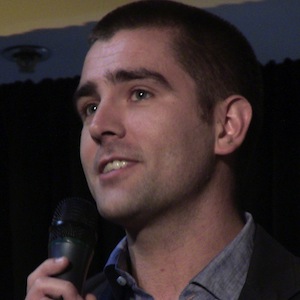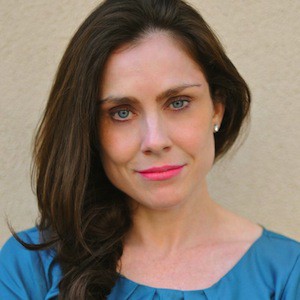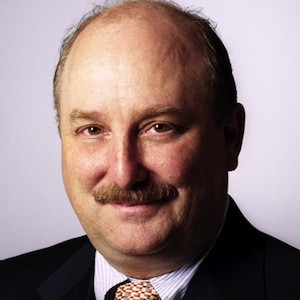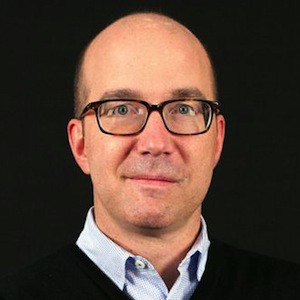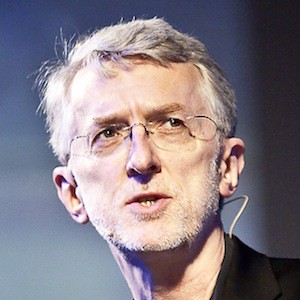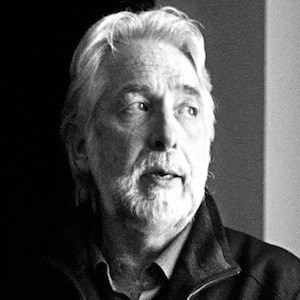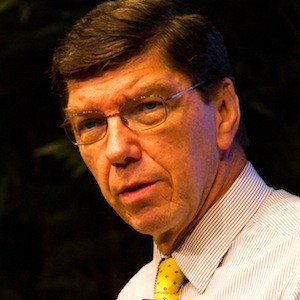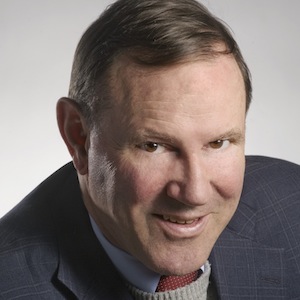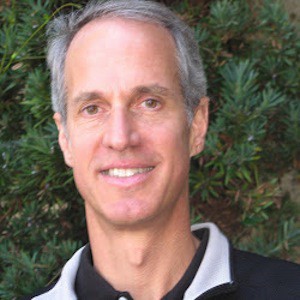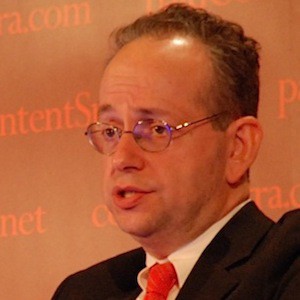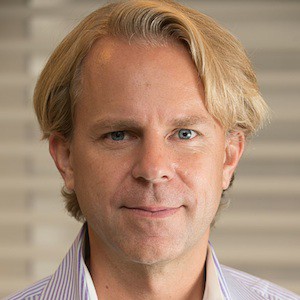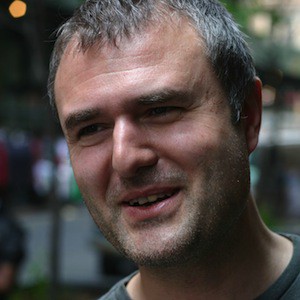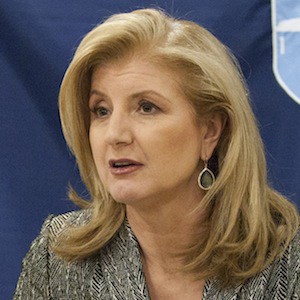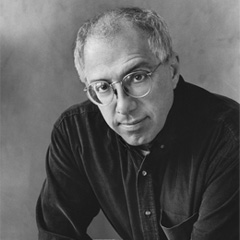John: It’s April 1st. John Huey and Martin Nisenholtz, interviewing Chris Cox at Facebook headquarters.
Martin: Facebook obviously was created without journalism in mind. Yet, even from the early days, you had this notion of a news feed, and even in the latest incarnation, actually talking about newspapers as metaphors. Can we start with the idea of news feed, and what that means to Facebook?
Chris: Totally. It really started with the core layer underneath the feed idea, which was this concept of the social graph. That was first explained to me when I interviewed at Facebook, almost eight years ago. It was 2005. I was talking to Dustin Moskovitz and Adam D’Angelo. Dustin was the VP of Engineering, and Adam was the CTO. They were two of Facebook’s super early employees. They were describing to me, who was a potential engineer, who they were trying to recruit to come on to the engineering team. This is November 2005.
Martin: And you had just graduated from Stanford?
Chris: I was a graduate student at Stanford.
Martin: OK.
Chris: My background was in AI and NLP, which is using computers to read. They described to me this idea that Facebook was the seed of a collaboratively created directory of people. At that time, Facebook had around 5 million users, so the idea that it was this seed of something that could grow to actually be really, really big, but that had the property that each member of that network was creating their own projection. So, it was a collaboratively built directory and it was interconnected. Each person was connecting to their real life friends.
That was a new idea to the extent that the rest of the networks that had existed on the Internet didn’t have the property that people tended to be themselves and tended to connect with people that they really knew in life.
But if you had a seed that had that property that was strong and engaged it was actually growing and could become something really, really exciting, which they were calling “The Social Graph” this idea of a collaboratively built directory of everybody in the world, where each person was responsible for their own entry in that directory.
Martin: They had that vision, even in 2005.
Chris: They did. We weren’t sure whether to call it “The Social Graph,” or whether to call it something else. There was a bunch of debate internally around what to call it, but the key thing they did have was the word “The,” which was important because it meant that the idea was to reflect something that was a reality that had just never been mapped out. That was a powerful idea, for me, as a graduate student, once I wrapped my head around it. Then, if you could imagine that existing, there’s this directory that you’re in, and your mom is in, and your sister is in, and your brother is in, and your roommate is in, and your college professor, all the way up to Barack Obama and John Boehner, and all of the public figures in the world Beyonce and influencers in every different category.
If you could imagine a world where every one of those people had an entry, and every one of those people were connected to the set of people in the world that interested them, you had the underpinnings of a circulatory system that could be a publishing platform, where each person was receiving updates from the set of people that interested them, all the way down to their cousin and all the way up to the President of the United States.
That publishing system they called “Feed,” and my job interview was, “How would you come in here and help us build feed?” Feed was to take the home page, which at that point told you how many friend request you had and turn it into this living newspaper and this was the words that they were using.
Martin: Even then.
Chris: Yes, it was called feed not news feed. It was cool, because at that time, it looked like Facebook was a college directory, right. But to contemplate having public figures on there and non college students on there and all other kinds of people was a really interesting idea. It was a powerful idea. So, feed was around as an idea at the company all the way back in 2005. I joined the company then and then spent the next year working with the small team to launch the first version, which was news feed. I was just taking the activity of Facebook and putting it on the homepage in a stream. It was very simple.
Martin: I remember when that happened and I have to tell you, because I have a very, sort of like the shoemaker’s son, I mean I had this very defined notion of news. I just didn’t at the outset understand the idea of news feed in that context.
Chris: Totally, and that makes a lot of sense because at that time on Facebook, there weren’t like buttons. You weren’t sharing links from the rest of the Web. You didn’t have a culture of a lot of the things that go on. There weren’t comments you can like a status update. There weren’t videos. There wasn’t a platform integration. There were a whole bunch of things that comprised the way we think about what Facebook is today that weren’t there. In short, Facebook wasn’t plugged into the rest of the Internet in 2006. It was this little world where people were updating things about their lives and those things were being shared inside of Facebook. But it bore little relation to the rest of the Internet, and the rest of the Internet bore little relation to it.
John: But it wasn’t walled but this wasn’t interactive.
Chris: It wasn’t super interactive and the main reason for that was one of the big innovations of Facebook was privacy. The idea that you could put a photo on the Internet and say I only want my friends to see this was not something that resonated with 99 percent of Internet users, because in 2005 the idea that you would upload a photo of yourself to the Internet was insane.
Martin: Or that you wouldn’t be anonymous.
Chris: That you would publish anything under your name was an insane idea to most people who are living outside of Silicon Valley or who weren’t already a part of broadcast media.
Martin: Right. So news becomes a metaphor for what, Chris? I mean for things that are relevant to you? I’m just trying to connect the dots here.
Chris: Totally. Well, when we launched news feed, it was not about…
Martin: …journalism.
Chris: …at all. It really wasn’t I mean with a capital J. We weren’t spending a lot of time thinking about our interaction with the news industry. But if you look at conversations between people as a proxy for what matters to them, if you were to just sit on top of city sidewalk and watch conversations all day long and ask, “What are people talking about?” you probably find that a lot of what they were talking about was not being reflected on the Internet yet, which is, “What’s going on with your cousin? How’s your baby? Tell me how work was yesterday? What did you do this weekend? Have you traveled anywhere recently? Are you going anywhere soon?” Those sorts of conversations, which are meaningful to us, did not yet have a home inside of a digital space, which is what we saw as Facebook sort of filling.
Martin: So from the outset, there were these identity, call them identity programs like Geocities and Tripod and then evolving into things like Friendster over time. Like your point is they were mostly anonymous worlds or they were…
Chris: They were all a little bit different. But I will say that from a social network perspective, you never had a social network that was also a living conversation. So Geocities was a bunch of conversations but it lacked, as you pointed out, authenticity and it lacks scale. So you weren’t getting my mom on Geocities. And my mom is important if you’re trying to recreate some of the aspects of the conversations that happen in the real world. For other sorts of social networks, you either didn’t have identity and authenticity at scale or you didn’t have conversations that were happening.
I think in retrospect that’s part of what was so interesting about news feed was that sort at the venn diagram of real people at scale and discussion and conversation, you had something growing for the first time.
Martin: OK. Now we’re in 2005, 2006. So you’re now beginning to, in a sense connect to the rest of the Web.
Chris: Yes.
Martin: What happens next? Was it the ‘share,’ or the ‘like’? I can’t remember.
Chris: So the like button came, I believe it was ’08. It may have been ’09. And share was around earlier than that. We noticed with most features we built in Facebook, we just watch what people did. They were usually trying to break a feature that already existed. And then you’re say, “Oh, well, people are going and checking each other’s profiles all the time. Let’s just build a page that shows you all the updates.” With share, we just noticed that people were cutting and pasting a lot of URLs into the little box that says what’s on your mind, which was an indicator that people wanted to share links which is a no brainer. It’d been happened on email for the last 15, 20 years.
So, the like button was taking the sort of obvious behavior that people like sharing links and just putting it underneath the title all over the Web. We built a simple one line of code that let any publisher say, “I want to put this on my article” and then people can like it and they can see which of their other friends liked it.
It was no brainer in retrospect of a feature.
John: So now you’re a news distributor?
Chris: Yes.
John: And you’re all in the journalism business?
Chris: Yes, which is cool because we were never writing content. I mean the cool part about our relationship with journalism is that we very, very, very clearly never wanted to create content. We’ve always said we’re a medium. We don’t create content here. We’re in Silicon Valley. We build this connective tissue so that people can quickly distribute content to their friends. That’s all we’ve ever done. We are all avid news readers. So if we can make it a little bit easier, remove a little bit of the friction between a great piece of content getting published on the New York Times and me finding out about it the next day. That’s awesome.
Except that the way we chose to do it was letting people connect to either an article or a journalist or the publisher themselves and then rely on being able to get some of that content from them when it’s good.
Martin: We’ll get into the kind of direct connect between journalism and his or her audience in a few minutes, because that’s a clear kind of, I wouldn’t say it’s a trend, but it’s certainly out there. The blogosphere. But it seems to me, so you went through this era, and this is a little bit more recent, of having a bunch of news companies create these things called social readers. It seems to me that that didn’t, I’m not sure how you feel about those as products. Without going into any single one of them, it just did never seem to me…
Chris: It didn’t work.
Martin: Yeah, I didn’t think it would, but why did you think it would work? Why didn’t it work in retrospect, I’m sorry.
Chris: I think there were a number of reasons it didn’t work. But I think in retrospect there was a level of intentionality that goes into the sharing of something you read that you liked that we didn’t in that product. Meaning, I liked this article and I didn’t like this article is the conversation that you and I have in the street. And we don’t have the conversation, “I read these 10 articles.”
John: OK. So it lacked authenticity in the Facebook environment?
Chris: Not even in the Facebook environment. It just didn’t reflect the real world.
John: Yeah, OK.
Martin: It’s not that useful.
John: It’s a pretty package.
Chris: It definitely wasn’t useful but I think the reason it wasn’t useful is that it didn’t reflect a conversation that you would ever have with somebody. You and I have never sat down, well, we don’t know each other, but you never sat down with a friend, go through all the articles you read.
Martin: Yeah.
Chris: You probably start with the ones that you liked. So there were a bunch of ideas for how this could turn into something really, really good. But what we decided was that this was just running uphill. The thing that was working really, really well was just being able to like something and share it. So, let’s just focus on that working nicely. And then this was cool idea but it didn’t work out so we censor it. We’ve been censoring it.
Martin: That makes sense. Now, bring us up to date in terms of where you are today with the latest iteration of news feed.
Chris: The latest iteration is trying to do two things. The first is make the content sort of more respectful of its original home. If you a link attachment inside of Facebook, all of our new designs are trying to do a better job of presenting the image, the headline, the author and the description in the way that an author represents them on sort of where the article is being published and that may seem like a nuance. But because the headline and the image get so much investment and time from the publisher, if we can make those a little bit bigger and a little bit nicer, we feel like we’re doing a better job of like having a good, strong, positive relationship with the publisher but also giving the user something that they understand and recognize “Oh, that’s from the New York Times. Oh, that’s from the Washington Post. Oh, that’s from the Economist.”
Martin: Talk about the overall vision here and how you think Facebook is changing the way people interact with journalism and both in terms of making it more useful but also in helping journalism continue in some very real way to a generation of people who are oriented toward information somewhat differently than the older folks. Maybe that’s a stereotype that you don’t want…
Chris: No, no, no, no, no. I mean I think the data supports what you’re saying is that younger people do not read newspapers as much as older people do.
Martin: Well, they never did. What I’m say [indecipherable 0:15:26] vis à vis…
John: But the difference is.
Martin: They never did.
John: Yeah, the older people didn’t have alternative means to…except for maybe the radio. But they didn’t have Twitter. They didn’t have Facebook. A young person can sit there and do nothing and they’re not going to miss most of the big stories. They might miss some of the nuances or some…Bt nothing big is going to happen in the world, they aren’t going to know about it because it’s going to just wash us in.
Chris: I think it’s too early to say it’s being fair, and I wouldn’t want to say, “Here’s exactly what they’re like, what’s going to happen to journalism.”
Martin: I’m not a [inaudible 0:16:09] . [crosstalk]
Chris: I can say that some of the most interest …
John: He’s already answered.
Chris: Well, I think one of the things it’s doing is letting, it’s exposing us to more types of information than we may have seen otherwise. A lot of studies that we’ve done kind of, that reference filter bubbles and the whole conversation are on filter bubbles. There is an argument that said, “The Internet is going to destroy deliberation because we’re all going to go into these corners where we’re each only going read the articles that come from the people that we’re close to and that we resemble.” We’ve done some studies that show that a lot of the content that people are actually reading are coming from a little bit more dissonant group of people, not their close friends, not the closest 20 friends but the next 500 people out.
John: Well, even intuitively, wouldn’t you think that they would get bored in a bubble with just 20 people ultimately?
Chris: Absolutely. But the interesting part about Facebook… [crosstalk]
John: …it’s boring.
Chris: Totally. But the interesting part about Facebook is that it didn’t really change your relationship with your 20 closest friends, because you were already calling them on the phone.
John: Right.
Chris: I think what’s interesting, what was new about Facebook, was your relationship with the next 200 people, who you didn’t call on the phone, and you didn’t have coffee with, and you weren’t writing emails to all the time.
John: One of them may be a Major League Baseball player, who’s your friend.
Chris: Each of them probably has some interest that you probably wouldn’t have happened upon and read about. I think where Facebook plays an interesting role in journalism is where each of those people now provides you a little bit of a signal on something you never would have looked at. That to me scales and becomes really, really interesting over the long run. I’m close friends with a guy named Aung Zaw, who’s the publisher of the Irrawaddy, which is one of the main journals that supplies information about what’s going on in Burma. He’s been living in Thailand for a long time. The reason he’s been living in Thailand is because he couldn’t publish a journal in Burma.
What he tells me is that the most important Internet service in Burma is Facebook, and the reason it’s important is because it gives people a reliable way of finding out which news and links are relevant to them, from a group of sources that they trust.
Martin: That’s really interesting.
John: Yes. If you look at the Arab Spring, and you look at Egypt, which Facebook became a part of geopolitical history in that event, it’s caused me to go back and look at past events like, say, the Civil Rights Movement. If you said that there wasn’t an institution of organized journalism, that was willing to put people in harm’s way, and stand up against the government in some instances…Or even the Pentagon Papers pick anything you want would social media have gotten a Civil Rights Movement? Would it have ended up in the same place, anyway? Would it have been quick? You don’t know.
Chris: I have no idea.
John: I don’t know either, but it makes you wonder.
Chris: Yep. I have to think that they’re both going to need to be around, and that one doesn’t replace the other. I don’t think…If you go look at Watergate, investigative journalism was not something that could have been funded by the kind of economics that social media currently creates for journalists.
John: No, but on the other hand, somebody might have tweeted you with something that…
Chris: That’s true.
John: Deep Throat might have been broadcasting.
Chris: [laughs] It’s true. I don’t know.
Martin: I doubt it, but…
John: Well I do, too. I’ve said this too many times in these interviews, but it seems to me that it’s harder to get away with anything today than it’s ever been. Now that may not be true at certain kinds of levels that are only ferreted out by…
Chris: I totally agree.
John: I mean, what can you get away with?
Chris: Yeah. And the other question is whether that will change what the public expects from their leaders.
John: Yeah. Or will they just get used to the fact that…
Chris: I have to think they will. I mean, the more that is exposed… [crosstalk]
Chris: Yeah. And you have to think that that will change, as well. You know, the more we learn that everybody has done something that they regret at some point in their life.
John: [indecipherable 0:20:27] late at night…
Chris: [laughs] But you have to think that that will change as well.
Martin: I’m on the board of a little company called Sulia.
Chris: Yeah, I know Sulia.
Martin: Good. Jonathan’s company. I don’t know whether he invented the phrase I don’t think he did but we tend to call what Sulia does the “interest graph.” What’s the interaction, in your view, between the social graph and the interest graph? Do you guys have any interest in channelizing what you’re doing, and finding the best people out in this huge place? Putting Sulia totally aside, I just used it as an example…To kind of organize this a little bit more coherently?
Chris: Totally. Facebook already uses concepts like “Where are you right now?” You’re in San Francisco, so we should show you events in San Francisco. It’s not the social graph. It’s knowing that you’re in San Francisco, and knowing that 12 of your friends are going to an event at the Elbow Room on Saturday, so maybe you should find out about it on Friday night. If you’re really interested in Alicia Keys, and she is in the news a lot, you’ll get a story that says, “Three recent articles about Alicia Keys.” We’ll know that you like Alicia Keys, and we’ll know that those are the most shared articles on the Web that day about Alicia Keys, so you’ll get a story about it. If you don’t like those stories, you X them out, you’ll stop getting them.
But on balance, we look at the performance of those in terms of, “Yeah, people do actually engage with these.” That’s looking like a super promising direction. The high level problem we think news feed tries to solve is, there are billions of pieces of content being created in a day now on the Internet. A lot of those are photographs, a lot of those are URLs that have long form content associated with them.
There are tweets, there are pins. There are all kinds of stuff going on, and that’s only going to accelerate. In that world, what is the system that’s going to help you find the 0.0001 percent of things that might actually be interesting to you, and might change your life? If you look at all of this information with that lens, you start to get at some of these things pretty quickly.
Martin: Recently, LinkedIn acquired, I think, Pulse, or maybe they’re trying to acquire Pulse. I could never quite tell whether they closed the deal or not.
Chris: I’m not sure.
Martin: I’m not, either. But that seems like another way in here. They have an algorithmic approach to organizing news content. Why do you think that what is, in essence, a social network, is becoming so much more structured? It’s purely usefulness, right?
Chris: Yes.
Martin: Making it more relevant, more useful, more…
Chris: I think it’s as simple as, these relationships have been, for a long time, the primary way we get information about our world. That could be gossip, it could be political opinions, it could be career advice. All of these things have come from a set of people in our life that we trust. That’s been true since the beginning of time. Until very, very recently, you didn’t have a way of super lightweight digital tools for using these relationships to share and discover information. That’s what’s happening, right now. Because Facebook and Twitter and LinkedIn are all sitting on versions of, “Who in the world do you use in order to help you figure out what’s going on and make decisions?”
It’s very, very natural to me that you would take an exploding amount of content on the Internet, and try and give people tools for using those relationships as a way of finding what’s interesting.
John: Isn’t part of the structure to do with the revenue model? The structure helps in targeting ad revenue.
Chris: Which structure?
Martin: The combination of all this rich data and intent, should be signals that…
Chris: In some ways…In an indirect way, it does help ad targeting. Although it’s not why we choose to go after “Let’s build a ‘Like’ button, and let’s give it to every developer and publisher on the Internet, so that if people see an article that they like, they can click it,” rather than opening email, and putting in the names of all the people they want to share it with, and then hitting ‘Share.’ They can just click a button, and that becomes a universal signal. That can be a really, really, really cool way of helping keep this kind of content alive. In a world of people growing up that don’t read newspapers. It’s that simple. We all grew up being news junkies, ourselves.
If you just look at a pie chart of what people do on the Internet, a lot of it is news, and a lot of it is entertainment. Most of the entertainment is watching music videos, or listening to videos, or reading celebrity gossip.
We always kind of looked at it as, “Well, to the extent that people are having conversations about this stuff all day long, what would it look like to project that city cafe into a space on the Internet? What would that even look like?” That’s really the quest we’ve been on for a while.
Martin: I take from your point before about creating content, that all of the folks who have written and talked about Facebook Twitter is a different company, and LinkedIn is a different company, and they can speak for themselves but Facebook acquiring the Washington Post, or something like that, in order to have a proprietary feed, just makes absolutely no sense to you?
Chris: No. If you look at what we’re doing now, it’s “Make great content.” That’s what you guys do. Put a “Like” button on it, we’ll give you one line of code and a “Share” button. And then, if people, when they see it and they read it, they can share it into Facebook, and when people click on it, more people will read your article. That’s a good deal for everybody involved. [laughs] [crosstalk]
Martin: I don’t know. The folks at Google feel the same way about Google News, and the whole link economy is…
John: But to get to the center of mediation part of the business model, Facebook even more than at Google, although Google has the lion’s share of the advertising of anybody Facebook would be the place where, when you talk to really thoughtful ad clients, they want to be talking directly to Facebook. They’re their own publisher now, right? Coca Cola. Those people. They’re a Facebook content creator and a revenue generator. That’s kind of a new model, isn’t it?
Chris: I don’t think so. They’ve been creating websites for years. They’re in the publishing business.
John: They’ve been creating websites, but kids don’t go to their websites, because who wants to go to the Coca Cola website?
Chris: That’s right.
Martin: No, it’s not right. They have one of the largest promotional destinations on the Web. They have a whole promotional suite. I forget what it’s called, it CokeZone or…
John: I know they have a lot of traffic, and they give away a lot of stuff.
Martin: They really do.
John: I just think that Facebook has become, to a generation, for a lot of brands…
Martin: No doubt.
John: It’s all content.
Martin: It’s yet another way for brands to publish directly to users.
John: So when you’re distributing this content…Can you talk a little bit about all the downstream companies that have come along in the wake of Facebook? Are they competitors, strictly, to you, or do they build an environment that you benefit from? There are so many things that feed off Facebook. How does that work in your head, when you look at it in the future?
Chris: I look at it as an accelerant to any idea spreading. The idea can be, “There’s a new app you should check out. It’s called Pinterest. Or Spotify. This is something I’m using, I want my friends to use.” Facebook becomes an accelerant for that app getting traction. It can also be an accelerant for a piece of journalism, or a publisher. That’s why you hear about reports about things like the Arab Spring. It can be an accelerant for discovering somebody that nobody really knew about before. There’s a phenomenon around George Takei, who’s become one of the biggest publishers in Facebook. He was somebody who wasn’t really in the public eye as a publisher.
In the idealized version, Facebook just makes it easier for a good idea, or a great person who is influential, to get their ideas out in a matter of seconds or minutes or hours, rather than months or years. That’s how we’ve always tried to engineer the system, in such a way that every person is getting the highest signal presentation of the content that was created in the last hour, that they could possibly care about.
The reason that we’ve built ourselves as a platform, so that Pinterest can plug in, and Instagram can plug in, and “The New York Times” can plug in, and Coca Cola can plug in, because in the economy of the future, attention is a scarce resource that is not growing. Information is exploding and growing exponentially fast.
That, to me, is the value function that defines the modern world. You have people waiting in line for the bathroom. They have their phone open. In that last hour since they’ve looked at their phone, a million world events have happened.
Here are 22 boxes with 22 little red dots behind them and they can go press them to figure out what’s going on. One of them is a blog, and one of them is a magazine, and one of them is Coca Cola. The question is, what are they going to do with their time?
We view Facebook, and this is why we’ve given this presentation of being a living newspaper, because so many people are using it, and because all of these publishers are plugged into it. It’s a good place to start, because it aggregates together all of these things for you, and then can launch you off into “The New York Times” or to Instagram, or to Pinterest, or what have you.
Martin: It’s a way station on the way to where you’re going, in a way. Just like Google is, was…
Chris: Google absolutely is in the domain of, “I’m trying to find something. How do I find it”? Facebook is building out a bunch of stuff around search. But, the original core of Facebook is not, “I’m trying to go do something. I’m trying to go find this. I’m trying to go do that.”
It’s, “I have five minutes. What’s going on”?
Martin: I’ve also always thought that the name of “Google hangouts” was ironic because Facebook actually is where you hang out. [laughter]
John: You don’t “hangout” at Google.
Chris: It’s been pretty successful, “hangouts” has been pretty successful, and they’re really cool.
John: We use it in this project. I’m not knocking the project. I think the branding is…
Martin: …is interesting.
John: …is inspired by Facebook. [laughter]
John: Because Facebook, like you say, you don’t go there to…You’re hanging out.
Chris: Yeah, and it’s more akin to just sitting on the side of a street and watching people go by, that doesn’t satisfy a task but it’s something we find ourselves doing a lot.
Martin: I guess what’s interesting to me is that, you talked about the places people go, but the places people go, whether it’s the New York Times, or the Bleacher Report, or whatever, Business Insider. I forget the guy’s name, but the guy that co created the Bleacher Report wrote a blog post recently about how content was a good place to be. I actually agree with him, I think he’s really running against a trend in venture capital that I think is wrong, which is that content is not a viable place to make an investment.
On the other hand…
John: He sold his company.
Martin: …If you want to have a huge home run, I mean huge, it’s never in content. It’s always in platforms, right? I think maybe that’s really the struggle that the content folks have with some of the relationships with companies like Facebook and Google in particular. It just seems sometimes like all the value accrues to the place you go to get the content, not to the content itself.
Chris: Yeah, is that true though?
Martin: I think it’s true from a market [indecipherable 0:33:36] perspective.
Chris: Is it true in music?
Martin: In music?
Chris: Yeah. Is it true in games? Look at “Angry Birds.” Angry Birds is an absolute runaway success in content. It was helped and accelerated by platforms like Apple and Facebook, but it absolutely was a runaway economic success all of its own.
Martin: Maybe in entertainment it’s different.
Chris: In film, in music, you’re going to find massive commercial success.
John: You’re back in the journalism tank.
Chris: In journalism, it’s a harder conversation.
John: In journalism it, tops out at two, $300 million, quits growing, and ultimately disappears. It’s a good play but you need to make it fast.
Martin: I mean Arianne’s company, Huffington Post, was a huge home run, 320, OK. 320 would be a joke in Facebook. So, that’s my only point that a huge home run in content is a rounding error in platforms.
Chris: That’s fair although I would say that both platforms and content are extraordinarily…our businesses where the exceptions are extraordinarily rare.
Martin: Absolutely. [crosstalk]
John: [indecipherable 0:34:54] platform that changes the world.
Chris: Well, that’s why I said what I said about the venture world. Maybe the…I’m not a venture capitalist so.
Martin: I’m not either. [crosstalk]
John: There’s a lot of hand wringing about the decline of the traditional business model surrounding journalism and it’s been going on quite a long time. It’s reached the sort of critical mass. Now, there’s a lot of things really are just dying or will soon be dead. There’s a lot of finger pointing and hand ringing and I think Eric Smith called it denial litigation.
Martin: There are four stages. [crosstalk]
John: But I think that and in the case of Facebook and the journalism industry or the publishing industry, traditional mainstream publishing industry, there’s been a lot of back and forth and there’s been deals and agreements, but how do you think that that industry views Facebook now? What do you think they are?
Chris: I can’t say as a whole how that industry views us. I mean I hope they view us as how I feel we are which is we don’t have an answer to how to save journalism but we are in a place to help and with some very simple tools we can do go a long way to make journalism have a more reliable and understandable home inside of Facebook. And it’s something we’re committed to trying to figure out with them.
John: You have a huge head start on several whole generations of how they get a lot of their information. You have a big block on that.
Chris: On what?
John: On younger generations of how they’re getting a lot of, if not most of the information that they’re getting, you and a couple of other, you and Twitter, say.
Chris: Different.
John: Very different.
Chris: Totally.
John: But without Facebook, would Twitter would have worked?
Martin: I think we’ve made an assumption here. What has Facebook done, Facebook reaches everybody basically. If you are a billion plus, it’s not only a young person…
Chris: It varies widely depending on where you look. I mean like I said…
John: I’m not saying only young people look at Facebook. I’m saying young people tend to get a much greater percentage of the information, I’m assuming, I could be wrong. I’m basing this on the fact that I have kids and they get all their information on Facebook whereas my contemporaries get of things off Facebook but they have multiple other inputs.
Chris: Yes.
John: Does that data support that?
Chris: So we don’t have any proprietary data that tells us what people do when they’re not on Facebook. What you’re reading in comScore or [indecipherable 0:38:10] or whatever cross media reports, are the same things we’re looking at that describe how young people or different demographic cuts interact with Facebook versus TV, radio, newspaper or other services. So I don’t have anything particularly insightful to say there. The thing to me that’s really interesting is if you look geographically at how different Facebook’s usage is in a place like the Middle East where there’s not as rich of an ecosystem of other mediums, where they can get the same sort information, so Facebook gets used much more for things like link sharing. Burma is another great example because there’s not reliable other channels that you can turn to to get a good story about what’s going on or at least this is what the data would suggest.
John: What are the percentages of US the numbers? It’s over a billion in total. Where is it?
Martin: How’s the breakdown?
Chris: It’s all over the world. I mean you can basically imagine it as a pretty good cut on the world right now if you take China out where Facebook is not available. We’re growing pretty quickly in the developing markets.
Martin: What’s the Chinese social network called, again?
Chris: There’s a few over there.
Martin: And Facebook is literally not available.
Chris: That’s right.
Martin: Neither is the New York Times. So… [crosstalk]
Martin: Is Time available?
John: On and off. Depends on what’s in it, week to week.
Martin: Where I was trying to go with this notion of the younger cohort is simply that, if John’s right, and there’s more of a concentration of young users, and this is a supposition, but let’s assume it’s true for now. I assume that part of the rationale for news organizations being more forceful on Facebook, is it’s a kind of on ramp for younger folks in terms of journalism. It could act as an on ramp.
Chris: Yeah, and it’s just free distribution. Putting the “like” button on an article takes a few minutes. It’s free distribution. I think the economics, in terms of how should I invest my time if what I care about is readership, are pretty simple in favor of “this is a tool.” On us, it’s just about how do we do a good job of getting that article in front of the people that want to read it.
John: And how does the publisher recover the cost?
Martin: It’s just pages.
John: Which, unfortunately, the economics of that are currently declining.
Chris: That’s another set of issues, but right now, we’re just trying to give distribution to people to create great content. It’s a simple deal for us, and hopefully for them.
Martin: Can you imagine a point which Facebook becomes a kind of, point of subscription, I mean, a kind of e commerce center? You’ve played around with virtual currency for a long time, and is there a way that you can imagine publishers using it as a subscription funnel? I’m just wondering whether you…
Chris: Sure.
Martin: I think that was the thinking behind some of the social readers, maybe the Wall Street Journal’s social reader. I don’t know, I wasn’t obviously part of that decision making. It just seems to me that if there’s going to be a really productive intersection going forward, it’s going to have to be in that arena. It’s going to have to be…not just Facebook sending traffic, which is valuable in my view. But it’s Facebook somehow becoming a kind of newsstand, for lack of a better metaphor. Since you’re using the newspaper metaphor in your news feed.
Chris: Sure. It’s absolutely possible. We offer simple tools right now, so any publisher can use a login with Facebook button if they want to, that’s another line of code.
Martin: Right. Of course, yeah.
Chris: Our strategy right now is build really, really, really simple tools, and let them get adopted and used. Then make them work better, and just work off of the organic activity that’s happening inside of their system. That’s how everything we’ve ever built that’s been successful, has worked. So, that’s really kind of where we’re focused right now.
Martin: What do you see next? Can you talk a little bit about where you’re going, rather than where you’ve been? I know this is an oral history, but we also ask people about…to look forward a little bit. I’m not talking about ten years.
John: Well, it’s a living history. We hope it continues.
Chris: Yeah, totally. The thing we’re really focused on is giving people better tools for organizing and curating their news feed. They spend a huge amount of their time on Facebook. Of their Facebook time, a huge amount of that is looking at news feed. But we haven’t yet started to build the really powerful tools for how you organize that and create sections out of that. Or different feeds of music or news or whatever else that you want to create. We’re spending a lot of time on giving people tools to do that.
So if you’re a hardcore music fan, it turns out all of the DJs and artists that you like are already on Facebook, or a lot of them are. All they want is to show up in San Francisco, and have all of their fans in San Francisco be at the show. In order to do that, they need a reliable way of getting all of their fans in San Francisco. That repeats itself for lots of different types of publishers in lots of different industries in lots of different places.
We’re focused on just taking this newspaper metaphor, which is different obviously from the New York Times, but it just says this is a place you can go to every hour or every day or every three days and get a reliable sense of what’s going on in these different areas that we care about. That’s really how we’re focused on approaching the future.
John: So, it becomes a richer creation tool, instead of just a consumption tool.
Chris: Absolutely. It’s also something that the reader has a lot more ownership over.
Martin: Do you have any…I’m not asking you to criticize or not criticize the business, but just in terms of Facebook, what have you learned from Twitter, that might be useful? Well, let me ask you the questions.
Chris: Yeah. I think one of the great learnings of Twitter is the simplicity of the model and how generative that can become in terms of the platform and the content that gets built upon it. I think from the very get go, that was something that Jack and the creators of Twitter were really focused on, is the simplicity of the model. The number of characters and the number of primitives, and the minimalism associated with Twitter. I think they’ve done a really nice job of executing on that.
John: But is that a limiting factor in any way? Going forward?
Chris: Things always beg to grow a little more complicated. [laughs] Everybody wants more tools and more features and very rarely do people write in and say could you take some stuff away. So, yes, there’s always a pressure, but I think that one of the great learnings of Twitter is the power of that simplicity.
Martin: Even though the stuff you’re creating is, in a funny way, making Facebook a little bit more complex.
Chris: Which things?
Martin: Well, the organizing. The notion of…yeah.
Chris: Sure.
Martin: I don’t mean to say that it makes it more difficult to use. But, I just mean to say, that it’s no longer as flat.
Chris: It’s no longer just one feed anymore. Yeah. We recognize that, but still, our intuitions, and the feedback we get suggest that it makes sense. You put it in front of people and they get it, and they like it. They’re not like, why are you giving me just my family. [laughs] Or why are you giving me just photos. [laughs]
John: [indecipherable 0:45:55] happenings like Instagram…
Chris: Yeah, and Instagram is a great example of photography itself being its own culture and its own…It’s not just the same kind of photo as on Facebook, it’s actually a pretty separate and slightly different culture. I think that’s really, really exciting. The best thing Facebook can do, in a world with Instagram and a bunch of other things like it, is to build a home where you can go to, that can sort of shoot you off to whatever is the most interesting.
Martin: What do you take from the vine experience? You obviously acquired Instagram…we’re now seeing the same kinds of tools beginning to emerge in video.
Chris: Yeah. It’s really cool. We’re about to have a world where billions of people have video cameras. That’s two decades after growing up, if somebody on your block got a handy cam, it was a huge deal because you all felt like maybe you could all become publishers one day, and maybe you could all become directors, and producers. There’s this little creator in all of us that gets excited about the idea of publishing something that could influence somebody. I think that’s real. I think if you look at why are all of these things succeeding right now, it’s because everybody has that inside of them.
Now, we’re having generations that grow up that aren’t just inundated with fear of the being online, and so they’re starting to publish things and it turns out it’s not so bad. And Vine, I think there’s probably going to be another 100 things like it that we can’t even imagine yet. [laughs] And that’s awesome. I mean what could be more exciting than that?
Martin: It would not be a Facebook interview if I didn’t touch on privacy for just a second.
Chris: [laughs] OK.
Martin: I know you’re interested in privacy, if you can believe what you read online.
Chris: [laughs]
Martin: Sorry.
Chris: Yeah.
Martin: Just talk about privacy a little bit. Are we in a kind of post privacy world, or do you think that’s just a cliché?
Chris: I think it’s meaning something different. I think privacy has always been a word that points to a disconnect between what you expect and what happens online. I think the more people are learning how to use these tools, and their friends and family are using them, and they’re becoming part of normal culture. That we’re just going to learn how they work. Privacy is always a problem. When caller ID came out it was all about privacy. No longer does anyone see who’s calling them and worry that it’s a privacy invasion because we’ve gotten used to it and we know how the tool works.
My sense is that it’s something we need to spend a lot of time on educating people on and we need to be very careful and responsible about, but that, like with any medium, the more people use it, the less people are trying to figure out how it works, and that it becomes OK.
John: I always thought caller ID was a perfect illustration of human nature. Everyone wanted to know who was calling them, and no one wanted anyone to know they were calling me. [laughter]
John: But you can’t have it that way.
